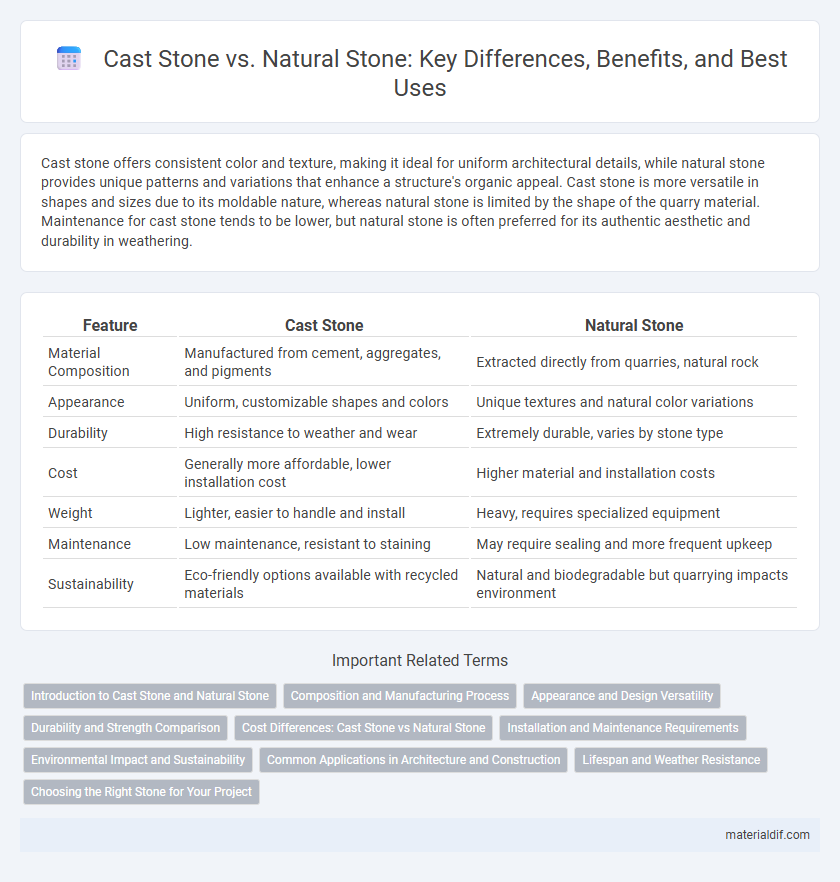Cast stone offers consistent color and texture, making it ideal for uniform architectural details, while natural stone provides unique patterns and variations that enhance a structure's organic appeal. Cast stone is more versatile in shapes and sizes due to its moldable nature, whereas natural stone is limited by the shape of the quarry material. Maintenance for cast stone tends to be lower, but natural stone is often preferred for its authentic aesthetic and durability in weathering.
Table of Comparison
| Feature | Cast Stone | Natural Stone |
|---|---|---|
| Material Composition | Manufactured from cement, aggregates, and pigments | Extracted directly from quarries, natural rock |
| Appearance | Uniform, customizable shapes and colors | Unique textures and natural color variations |
| Durability | High resistance to weather and wear | Extremely durable, varies by stone type |
| Cost | Generally more affordable, lower installation cost | Higher material and installation costs |
| Weight | Lighter, easier to handle and install | Heavy, requires specialized equipment |
| Maintenance | Low maintenance, resistant to staining | May require sealing and more frequent upkeep |
| Sustainability | Eco-friendly options available with recycled materials | Natural and biodegradable but quarrying impacts environment |
Introduction to Cast Stone and Natural Stone
Cast stone is a versatile architectural concrete product designed to simulate natural stone, offering consistent quality and customizable shapes for construction and ornamental use. Natural stone, derived directly from quarries, provides unique textures and colors formed over geological time, prized for its durability and authentic appearance. Understanding the differences in composition, cost, and application is essential when selecting between cast stone and natural stone for building projects.
Composition and Manufacturing Process
Cast stone is a manufactured material composed primarily of cement, aggregates, and mineral oxides, blending finely crushed natural stone with Portland cement to simulate natural stone's appearance. Its production involves molding and curing in controlled environments, allowing consistent color, texture, and customized shapes. Natural stone consists of quarried solid rock such as granite, limestone, or sandstone, shaped through cutting and polishing processes without chemical additives, resulting in inherent variations in color and texture.
Appearance and Design Versatility
Cast stone offers consistent color and texture, enabling precise control over appearance, while natural stone features unique, organic variations that add character to each piece. The moldability of cast stone allows for intricate shapes and customized designs, surpassing the limitations of natural stone's irregular forms. Designers prefer cast stone for uniformity and versatility, whereas natural stone appeals for its authentic, one-of-a-kind aesthetic.
Durability and Strength Comparison
Cast stone offers consistent durability and high compressive strength due to its controlled manufacturing process, making it resistant to weathering, chipping, and cracking. Natural stone, such as granite or limestone, exhibits variable strength and durability depending on its mineral composition and porosity, often requiring maintenance to prevent erosion and damage. While natural stone provides unique aesthetics and historical authenticity, cast stone is preferred for structural applications demanding uniform strength and long-term performance.
Cost Differences: Cast Stone vs Natural Stone
Cast stone typically costs 30-50% less than natural stone due to lower material and fabrication expenses. Its production process allows for mass manufacturing, reducing labor costs compared to the extensive quarrying and cutting required for natural stone. Maintenance and installation of cast stone are also generally more affordable, making it a cost-effective alternative for many architectural projects.
Installation and Maintenance Requirements
Cast stone offers easier installation due to its uniform sizes and lighter weight, reducing labor costs and time compared to natural stone. Maintenance of cast stone typically involves cleaning with mild detergents and periodic sealing to prevent staining, whereas natural stone may require specialized sealants and more frequent upkeep to preserve its surface and structural integrity. Both materials benefit from proper installation techniques, but cast stone's controlled manufacturing process simplifies fitting and alignment on-site.
Environmental Impact and Sustainability
Cast stone production generates lower carbon emissions compared to natural stone quarrying, as it involves less energy-intensive extraction and processing. Natural stone quarrying often leads to significant habitat disruption and waste generation, whereas cast stone uses recycled aggregates and industrial by-products, enhancing material sustainability. The use of cast stone reduces transportation emissions due to its ability to be produced closer to construction sites, making it a more eco-friendly choice for sustainable building projects.
Common Applications in Architecture and Construction
Cast stone offers versatile applications in architectural elements such as facades, columns, and decorative moldings due to its ability to mimic natural stone textures while allowing for precise shaping and uniformity. Natural stone remains preferred for structural components like load-bearing walls, paving, and monumental sculptures where durability and authentic appearance are paramount. Both materials are widely used in exterior cladding, landscaping features, and interior design, with cast stone providing cost-effective alternatives and natural stone delivering timeless aesthetics.
Lifespan and Weather Resistance
Cast stone offers enhanced weather resistance due to its engineered composition, which reduces porosity and minimizes the risk of cracking or erosion over time. Natural stone, while renowned for its robust lifespan, can be more susceptible to environmental factors such as freeze-thaw cycles and acid rain. Both materials provide durable options, but cast stone typically requires less maintenance and maintains structural integrity longer in harsh weather conditions.
Choosing the Right Stone for Your Project
Cast stone offers consistent color and texture, making it ideal for uniform architectural elements, while natural stone provides unique variations and a more authentic, organic appearance. Consider project requirements such as durability, budget, and aesthetic preferences; cast stone tends to be more cost-effective and versatile in shape, whereas natural stone often commands higher investment and requires specialized installation. Selecting the right material involves balancing longevity and design goals to ensure the stone complements both function and style.
Cast Stone vs Natural Stone Infographic

 materialdif.com
materialdif.com